|
It's a Brave New World
|
|
Pinnacles and Top Flites might not stick on a 7,000 square foot green after a torrential downpour. Titleists might check up in the fairway, putting the kibosh on the final 10 yards of your prodigious 300-yard blast.
Looking at the quality and quantity of golf balls available today, it's a brave new golf ball world, and all preconceived notions about this ball and that ball are just that - preconceived.
Because Top Flite has a ball that spins, Titleist has a ball that hauls, and Strata, Maxfli, Taylor Made, Nike, Callaway, Precept, and Pinnacle offer more types of balls within their respective lines than you can shake a shag bag at.
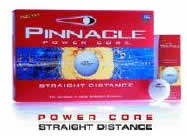 Just how hard has it become to choose a sleeve of balls for your weekend Nassau? Dana Rader, golf instructor at the Dana Rader Golf School at Ballantyne Resort recommends a visit to a teaching professional.
Just how hard has it become to choose a sleeve of balls for your weekend Nassau? Dana Rader, golf instructor at the Dana Rader Golf School at Ballantyne Resort recommends a visit to a teaching professional.
"I think it benefits players to get an assessment of what their shot tendencies are," she says. "If you hit a low ball, you'd be better off with a ball that spins. If you hit it high, you might need a hard ball. This doesn't necessarily have to be a lesson. Just pull a teacher aside at the local course and ask what they think."
Still, some golfers stick to the old fashion selection methods.
"I will also reach for the Top Flites because of the price and the 18-packs," says North Myrtle Beach resident Jim Blair.
Blair's system overlooks one minor detail: the golf ball is one of the most highly engineered balls in the sports world, with more than 5,000 design patents granted since 1990. Perhaps it is a decision that should not be taken so lightly.
"Choosing a ball is just as critical to your game as selecting the right clubs," said Jason Paul, Golf Director for Marriott's Westfields Golf Club in Virginia. "There are real differences in golf ball feel and performance. However, players should avoid getting caught up in the latest buzz, and pick the ball that matches your skill level and feels comfortable."
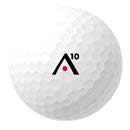 Ultimately, golf balls are constructed to control distance and spin. Here's a quick primer, developed by the experts, covering ball construction, compression, and materials:
Ultimately, golf balls are constructed to control distance and spin. Here's a quick primer, developed by the experts, covering ball construction, compression, and materials:
Solid Two-Piece - The workhorse of all balls, beginners should start here. It is a solid, rubbery ball that is durable and affordable at $18-$30 a dozen. Comprised of a large, uniform inner core beneath a hard cover, players can hit a "thin" or "fat" shot with less fear of splitting the ball. The tradeoff is low spin or less control for greater distance and a longer roll.
Multi-Layered or Three-Piece - Preferred by intermediate players, this softer ball achieves a higher spin rate, and consequently, price tag of about $28-$45 a dozen. The tradeoff is more control for less distance.
High Performance - Intended for low handicap players, the ball is less durable with a softer cover for more control. The design provides the best of both worlds - high spin and distance - at a cost of $45 to $60 per dozen. They are not recommended for beginners since they cut and deform easily.
Next, players must consider the ball's compression rating, defined by how tightly the ball is wound. The slower the swing, the lower the compression needed. However, a player's own skill level and personal preference will be the deciding factor. The three most common ratings are:
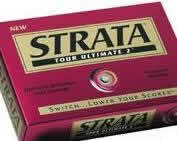 80 - Lower compression balls are also the softest. This provides a sling shot effect, which propels the ball further. Yet, it is harder to control. Typically chosen by women, juniors and senior players.
80 - Lower compression balls are also the softest. This provides a sling shot effect, which propels the ball further. Yet, it is harder to control. Typically chosen by women, juniors and senior players.
90 - Played by the majority of male players and experienced female players.
100 - The hardest compression, this rating is best suited for advanced players with fast swing speeds.
Beginners needing durability should not overlook the golf ball cover. The material plays a large role in determining performance. The top three cover materials are:
Surlyn - Prized for its durability, cut-resistance, distance and affordability, it's the most widely used material on the market.
Balata - Softer and more expensive, the material is valued for spin, feel and control. However, it is more likely to get nicks and cuts.
Elastomer - Used by low-handicap players, who want spin without sacrificing too much durability.
The weather report also influences which ball to choose. Warm conditions can expand balls, calling for players to use a higher compression. A harder ball helps in high humidity or in low sea level areas, where thick air slows the ball down.
Conversely, cold weather tends to harden the ball. Players can counteract the effect by choosing lower compression balls. Softer balls also help in high altitudes where air is thinner and there is less resistance.
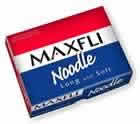 What's new in 2002
What's new in 2002
Spalding -- Between its Top Flite and Strata lines, Spalding has emerged as a major player in the golf ball industry. The Strata Tour Ultimate 2 launched in 2001 was wildly successful, and Spalding followed up in 2002 with a complete line of Stratas, including the new Tour Professional and Professional Control models.
Back in 1996, Strata was the first multi-layer ball played on the PGA Tour, and now close to 80 percent of tour players have followed suit. The new Tour Professional model has proven to be eight yards longer off the driver than its predecessor, the Tour Professional 90. Suggested retail for the Tour Professional is $44, and $39 for the Professional Control.
Spalding also introduced the Top Flite XL 3000, the follow up to its mega popular 2000 series. The XL 3000 is all about distance, as it sports a firmer Beta Titanium cover, and Tungsten core. But this is not your father's Top Flite. The ball comes in a Super Long (firmer cover), Super Feel (low compression core), Super Straight (Teflon coat) and Super Spin (soft cover) editions.
Wilson -- Wilson created quite a buzz at an otherwise subdued 2002 PGA Merchandise Show in Orlando, Fla. by introducing its new Wilson Staff "True" golf ball. Wilson officials claim to have created a perfectly balanced golf ball, and the company put on a series of demonstrations at its booth utilizing a robotic putter to prove that the True ball rolls straighter than any other pellet on the market.
Titleist -- Golf shops couldn't keep the Pro V-1's in stock in 2001, and Titleist is hoping its 2002 offering, the NXT Tour and Distance models, are just as successful. Titleist also unveiled its follow up to the Pro V-1, the Pro V Star, which company officials describe as a "niche'' companion to its seductive sibling. The NXT is Titleists answer to an affordable, two piece ball, and sports the largest core in the industry (retail $34 per dozen).
Maxfli -- Maxfli's 2002 offerings anchor the two ends of the golf ball spectrum. The Noodle (named for its propensity to be long and straight) retails at $25 a dozen, while the sporty A10 is one of the most expensive balls on the market, at a suggested retail of $52 a dozen. The Noodle has a soft Surlyn cover, and features a low 55-compression solid core. The overall ball compression is 80, the lowest of any Maxfli ball.
The A10 is designed for low handicappers and Tour pros, and features a solid tungsten core. Iron Byron testing has actually shown the A10 is longer off the driver than the Pro V-1, the Nike Tour Accuracy, and the Callaway Rule 35. 2002 will mark Maxfli's first full year of distribution of the A10, which has already netted 17 Tour wins.
Pinnacle -- Let's put it this way -Pinnacle isn't throwing any endorsement opportunities Justin Leonard's, Corey Pavin's, or Jeff Sluman's way. Big John Daly is the front man, and that tells you all you need to know about this venerable, immensely popular golf ball. Oh, that and the Pinnacle Distance Challenge, where you can take on one of the company's designated long drivers (including Big John), and instantly win $10,000 if you whip him.
Pinnacles two offerings for 2002 from its popular Power Core line are the Straight Distance ball and Soft Feel balls. Both balls utilize a Surlyn cover, with the primary difference being the Soft Feel's low compression core. Pinnacle also offers the classic Gold series, which has been expanded to include Gold Distance, Gold Distance Senior, and Gold Distance Lady. Still the most affordable ball on the market, suggested retail for the Power Core series is $20 for a box of 15, and $16.25 for the Gold Distance series.
Agree with this review? Disagree?
Post your thoughts at GolfBoards.com.
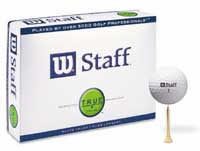 PRODUCT REVIEW
PRODUCT REVIEW